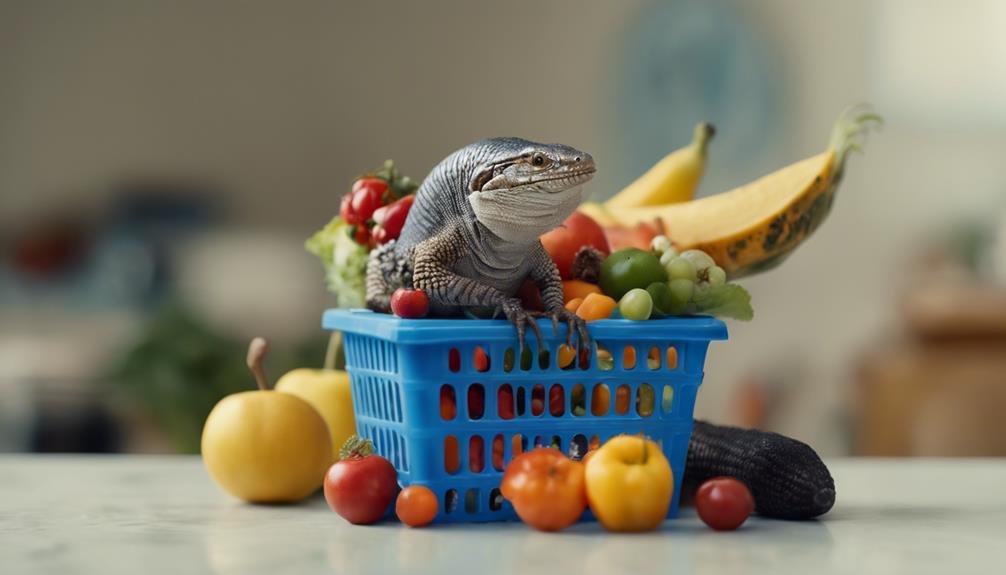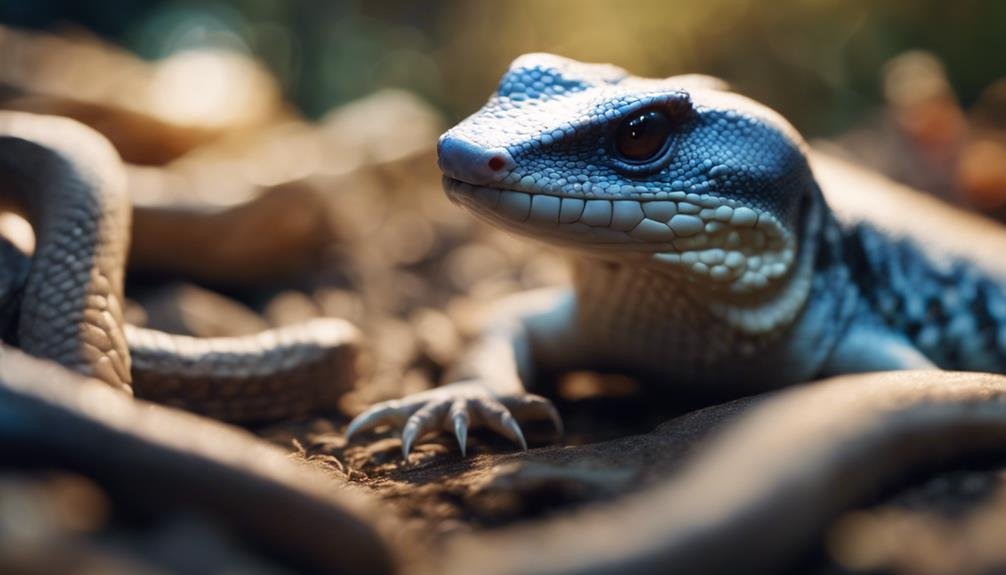If you're thinking about adding a blue tongue skink to your family, you've likely noticed the wide range in prices and may wonder what contributes to the cost. From the initial purchase, which can swing between $100 to well over $1,000 based on the morph and breeder's reputation, to the ongoing expenses for their care, there's a lot to think about. Beyond the sticker price, the habitat setup, daily feeding, and vet visits add layers to the financial commitment. Let's explore what makes these unique reptiles both an intriguing and significant investment, hinting at why understanding the full scope of their upkeep is important for prospective owners.
Key Takeaways
- Initial purchase price for a Blue Tongue Skink ranges from $100 to over $1,000, influenced by age, morph, and breeder.
- Habitat setup costs can vary between $300 to $500, including enclosure, heating, lighting, and decor.
- Daily feeding expenses are estimated to be between $0.50 to $1.00, with diet consisting of vegetables, fruits, and proteins.
- Regular veterinary visits for health maintenance cost between $50 to $100, not including additional medical treatments.
- Adopting or rescuing a Blue Tongue Skink can cost between $50 to $150, offering a more budget-friendly option.
Initial Purchase Price
The initial purchase price for a Blue Tongue Skink can vary widely, ranging from $100 to over $1,000, influenced by factors like the skink's age, morph, and the breeder's reputation. If you're venturing into reptile care, understanding how much it costs to buy a Blue Tongue Skink is essential.
High-quality morphs or those with rare colorations can command prices upwards of $1,000, reflecting the unique nature and demand for these reptiles. Opting for a skink from a reputable breeder might cost you more initially, but it's a wise investment towards getting a healthier animal.
Alternatively, if your budget is tight, consider adoption or rescue. Adopting a Blue Tongue Skink can significantly reduce your initial outlay, typically costing between $50 to $150. This route not only saves you money but also gives a home to a skink in need.
Habitat Setup Costs
After securing your new Blue Tongue Skink, you'll need to focus on creating a comfortable living space, which can cost anywhere from $300 to $500. This range depends on the enclosure size and quality you choose for your reptile. The habitat setup isn't just about a tank; it's about creating an environment that mimics their natural surroundings as closely as possible.
Heating elements, lighting, and humidity control are pivotal in this setup, playing a vital role in the initial costs. These factors play a key role in making sure your skink stays healthy, mimicking the warmth and light cycles they'd experience in the wild. Remember, the right temperature and humidity levels are essential for their well-being.
You'll also want to invest in hides, decorations, and enrichment items to enhance your skink's living area. These not only make the habitat more visually appealing but also provide necessary hiding spots and stimulation for your skink, mirroring the complexity of their natural environment.
Choosing durable and safe materials for the habitat is crucial for long-term cost-effectiveness. This upfront investment in a proper habitat setup is essential for your skink's overall health, ensuring they thrive under your care.
Daily Feeding Expenses


Caring for your Blue Tongue Skink requires understanding the daily costs of their diet, which can range from $0.50 to $1.00 per day. This expense is based on a variety of foods they consume, including vegetables, fruits, insects, and the occasional small rodent. While the initial glance at these costs might seem minimal, it's important to factor in the variety needed to maintain a balanced diet important for their health and overall well-being.
Opting for commercially prepared skink diets might seem like a convenient choice, yet it's worth noting that these can increase your feeding costs. Despite the higher price, these commercial diets can simplify providing a balanced nutrition for your skink, ensuring they get all the necessary vitamins and minerals without the hassle of preparing a varied diet yourself.
Feeding frequency is another important aspect to consider. While adults require food 3-5 times a week, juveniles need feeding daily, impacting your overall expenses. Balancing the cost while ensuring your skink's dietary needs are met is key to their care. Remember, investing in quality food pays off in your skink's health and happiness.
Health Care and Vet Visits
Beyond feeding, it's important to take into account your Blue Tongue Skink's health needs, including regular vet visits and potential medical costs. Regular health check-ups are highly recommended to keep an eye on their well-being and catch any issues early on. You'll likely need to budget for veterinary visits, especially for specific health concerns like respiratory infections, parasites, or injuries. These visits can set you back $50 to $100 per consultation, not including any extra treatments or medications.
To guarantee the overall health and longevity of your skink, setting aside money for routine veterinary care is essential. Remember, the frequency of these visits can often be reduced by maintaining proper hygiene, a balanced diet, and ideal environmental conditions for your pet. For example, consistently spot cleaning their habitat and providing a diet that includes high-quality cat foods can greatly contribute to their health.
These practices not only support your skink's well-being but also help prevent common health issues, ultimately saving you money on vet visits in the long run.
Breeding Program Operations


Starting a breeding program for Blue Tongue Skinks requires dedication, as it involves significant time, resources, and meticulous planning. You'll need to invest in the right equipment, making sure that your setup meets the needs of your reptiles. From the enclosures at Reptile Mountain to the specialized diet provided by Omni Gold, every detail counts in creating an ideal breeding environment.
Regular maintenance and upgrades to your setup aren't just recommended; they're vital. This ongoing investment keeps your skinks healthy and your breeding program sustainable. Veterinary care is another essential expense. Routine health checks ensure your breeding stock remains in prime condition, ready to produce the next generation of skinks.
But it's not all about the animals. Marketing your breeding program is crucial. You'll need to reach out to potential buyers, showcasing the quality and care that goes into each skink you breed. Keeping detailed records is also essential. From genetic data to individual health histories, this information helps you manage your breeding program effectively.
Will the Cost of Upkeep for a Blue Tongue Skink Include Their Food Expenses?
Yes, the cost of upkeep for a Blue Tongue Skink will include their food expenses. When considering the budget for caring for these reptiles, it’s important to factor in the cost of their food. Fortunately, there are plenty of affordable and nutritious blue tongue skink diet suggestions available for owners to explore.
Frequently Asked Questions
How Expensive Is a Blue-Tongued Skink?
You're looking at a pretty penny to own a blue-tongued skink. Beyond the initial purchase, which varies greatly depending on skink legality and where you're buying from, you've got to factor in breeding costs if you're going that route.
Annually, you'll spend $500 to $700 just for basic care. Add electricity for their habitat, substrate changes, and food, and you're looking at significant upkeep costs.
Are Blue-Tongue Skinks High Maintenance?
No, blue-tongue skinks aren't high maintenance. You'll find their care quite straightforward. Their diet variety, including fruits, vegetables, and insects, is easy to manage.
While you'll need to keep an eye on their health, regular health monitoring and vet visits aren't overly demanding. Just make sure their tank is clean, and they've a comfy environment.
Can a Blue Tongue Skink Live in a 55 Gallon Tank?
Yes, a Blue Tongue skink can comfortably live in a 55-gallon tank. It's important to make sure the tank dimensions provide ample floor space for your skink to explore.
You'll also want to focus on habitat enrichment by adding hides, branches, and other elements to simulate a more natural environment. Secure lids are a must to maintain humidity levels stable and prevent escapes.
Can a Blue Tongue Skink Live in a 20-Gallon Tank?
You're wondering if a 20-gallon tank can house your blue tongue skink, right? Well, it's not the best choice. They need a lot of space to thrive, and a 20-gallon tank just won't cut it for their space requirements and tank enrichment activities.
You're better off starting with at least a 40 to 75-gallon tank to keep them healthy and happy. This way, you're also saving yourself from future upgrades as they grow.
Conclusion
To conclude, purchasing a Blue Tongue Skink can range from $100 to over $1,000, depending on your preferences.
However, it's important to remember that the initial cost is just the start. Setting up their habitat, providing daily meals, regular vet check-ups, and possibly engaging in a breeding program will all contribute to your expenses.
Therefore, ensure you're prepared for the commitment and financial responsibilities involved in caring for these amazing creatures.


